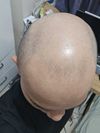community Before & after for 3 months of minoxidil & 6 months of finasteride/minoxodil/tretinoin
A 36-year-old experienced significant hair regrowth using minoxidil, finasteride, and tretinoin with minimal side effects. He plans to continue the treatment, hoping for more targeted solutions in the future.

